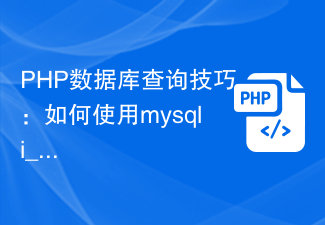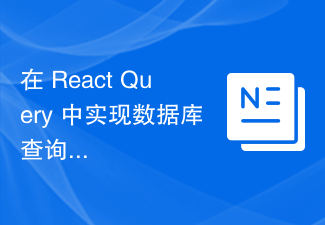Java is a programming language widely used to develop various software and systems, and in many applications, database query is a common and critical operation. However, sometimes when performing database queries, we may encounter a situation where the query results are empty. This article will introduce some ways to solve this problem.
First of all, there may be many reasons why the query result is empty. One of them is that the query conditions are incorrect, resulting in no matching data being retrieved. To solve this problem, we need to double-check that the query conditions are correct and make sure they match the data in the database.
Secondly, there may be no data matching the query conditions in the database. In this case, we can try to find relevant data by querying other tables in the database or adding broader query conditions. In addition, you can check whether there are missing data records or data accuracy issues in the database.
Another common situation is that the query statement is incorrectly written and no data is returned. In this case, we should carefully check the syntax and logic of the query statements to ensure that they can correctly retrieve data from the database. You can use database query tools to test and verify the correctness of query statements.
In addition to the above methods, you can also use try-catch blocks to capture database query operations that may cause exceptions. By catching exceptions, we can detect whether the query operation fails and determine the problem based on the corresponding exception information. For example, database connection exceptions, query syntax errors, or database access restrictions.
In addition, we can also use debugging methods to solve the problem of empty database query results. By adding log output to our code, we can trace and analyze every step of the query operation to determine the specific cause of the query error. By printing the values of relevant variables, entering debugging mode, and using debugging tools, we can better understand the execution process of the code and discover hidden problems.
Finally, in addition to the methods listed above, we can also use the tools and technologies provided by the Java framework to solve the problem of empty database query results. For example, you can use ORM frameworks (such as Hibernate, MyBatis, etc.) to simplify database operations, use query builders (such as CriteriaQuery, QueryDSL, etc.) to build complex query conditions, or use caching technology to improve query performance and avoid empty results.
To sum up, when encountering a situation where the database query result is empty in Java development, we can solve the problem through the following methods: check the correctness of the query conditions, expand the query scope, and check the data records and accuracy, check the syntax and logic of query statements, use try-catch blocks to catch exceptions, find the root cause of problems through debugging methods, and use the tools and techniques provided by the framework to simplify operations. By comprehensively applying these methods, we can quickly and effectively solve the problem of empty database query results and improve the reliability and performance of the system.
The above is the detailed content of How to solve the problem of null query results in Java development. For more information, please follow other related articles on the PHP Chinese website!
 Java开发中如何解决数据库查询数量溢出问题Jun 29, 2023 pm 06:46 PM
Java开发中如何解决数据库查询数量溢出问题Jun 29, 2023 pm 06:46 PMJava开发中如何解决数据库查询数量溢出问题标题:Java开发中如何解决数据库查询数量溢出问题摘要:随着互联网的发展和数据量的逐渐增大,数据库查询的数量也越来越大。在Java开发中,由于内存的限制,可能会遇到数据库查询数量溢出的问题。本文将介绍几种解决这个问题的方法。正文:优化数据库查询语句首先,我们可以从优化数据库查询语句的角度来解决这个问题。我们可以使用
 Laravel中间件:为应用程序添加数据库查询和性能监控Jul 28, 2023 pm 02:53 PM
Laravel中间件:为应用程序添加数据库查询和性能监控Jul 28, 2023 pm 02:53 PMLaravel中间件:为应用程序添加数据库查询和性能监控导言:在开发Web应用程序时,数据查询和性能监控是非常重要的。Laravel提供了一种方便的方式来处理这些需求,即中间件。中间件是在请求和响应之间进行处理的一种技术,它可以在请求到达控制器之前或响应返回给用户之后执行一些逻辑。本文将介绍如何使用Laravel中间件来实现数据库查询和性能监控。一、创建中间
 PHP数据库查询技巧:如何使用mysqli_query函数执行SQL查询Jul 29, 2023 pm 04:42 PM
PHP数据库查询技巧:如何使用mysqli_query函数执行SQL查询Jul 29, 2023 pm 04:42 PMPHP数据库查询技巧:如何使用mysqli_query函数执行SQL查询在开发PHP应用程序时,与数据库的交互是一个非常重要的部分。对于查询操作,PHP提供了一些内置的函数来执行SQL语句。本文将重点介绍mysqli_query函数的使用方法,帮助开发者更好地进行数据库查询操作。一、mysqli_query函数介绍mysqli_query函数是PHP的内置函
 在 React Query 中实现数据库查询的错误处理机制Sep 28, 2023 pm 02:40 PM
在 React Query 中实现数据库查询的错误处理机制Sep 28, 2023 pm 02:40 PM在ReactQuery中实现数据库查询的错误处理机制ReactQuery是一个用于管理和缓存数据的库,它在前端领域越来越受欢迎。在应用程序中,我们经常需要与数据库进行交互,而数据库查询可能会出现各种错误。因此,实现一个有效的错误处理机制对于保证应用程序的稳定性和用户体验至关重要。第一步是安装ReactQuery。使用以下命令将其添加到项目中:n
 在 React Query 中优化数据库查询的前端性能策略Sep 26, 2023 am 11:38 AM
在 React Query 中优化数据库查询的前端性能策略Sep 26, 2023 am 11:38 AM在ReactQuery中优化数据库查询的前端性能策略在现代的前端开发中,我们经常需要与后端的数据库进行交互,获取数据来渲染页面。然而,频繁的数据库查询可能会导致性能问题,特别是当页面需要渲染大量的数据时。在这种情况下,我们可以使用ReactQuery来优化数据库查询的前端性能。ReactQuery是一个用于管理数据查询和状态的JavaScr
 Laravel开发:如何使用Eloquent ORM进行数据库查询?Jun 14, 2023 pm 12:47 PM
Laravel开发:如何使用Eloquent ORM进行数据库查询?Jun 14, 2023 pm 12:47 PMLaravel是一款流行的PHP开发框架,提供了一系列的工具和辅助函数来加快Web应用程序的开发速度。其中,EloquentORM是Laravel框架中用于数据库操作的工具之一,让Laravel开发者可以更快捷地对数据库进行查询和操作。在本篇文章中,我们将深入探讨如何使用EloquentORM进行数据库查询。安装EloquentORM首先,我们需要在L
 PHP高性能:如何优化数据库查询Jun 04, 2023 am 08:40 AM
PHP高性能:如何优化数据库查询Jun 04, 2023 am 08:40 AM在当前互联网时代,随着数据的爆炸式增长,数据库成为了一个服务的核心。数据库的性能和速度更是直接影响了网站及其应用的用户体验和可用性,因此如何优化数据库查询是开发人员需要着重研究的一个问题。而在PHP语言中,通过对数据库查询语句的优化,可以提高程序的性能,减少服务器的负担,提高服务的稳定性。本文将从以下几个方面,介绍如何优化数据库查询:一、使用索引在进行查询时
 在 React Query 中实现数据库查询的日志记录Sep 26, 2023 pm 03:12 PM
在 React Query 中实现数据库查询的日志记录Sep 26, 2023 pm 03:12 PM在ReactQuery中实现数据库查询的日志记录,需要具体代码示例前言在开发中,我们经常需要向数据库进行查询操作。为了更好地追踪和监控这些查询,常常会需要记录查询的日志。本文将介绍如何在ReactQuery中实现数据库查询的日志记录,并提供具体的代码示例。ReactQuery简介ReactQuery是一个用于管理和维护前端应用程序状态的库


Hot AI Tools

Undresser.AI Undress
AI-powered app for creating realistic nude photos

AI Clothes Remover
Online AI tool for removing clothes from photos.

Undress AI Tool
Undress images for free

Clothoff.io
AI clothes remover

AI Hentai Generator
Generate AI Hentai for free.

Hot Article

Hot Tools

SAP NetWeaver Server Adapter for Eclipse
Integrate Eclipse with SAP NetWeaver application server.

MinGW - Minimalist GNU for Windows
This project is in the process of being migrated to osdn.net/projects/mingw, you can continue to follow us there. MinGW: A native Windows port of the GNU Compiler Collection (GCC), freely distributable import libraries and header files for building native Windows applications; includes extensions to the MSVC runtime to support C99 functionality. All MinGW software can run on 64-bit Windows platforms.

VSCode Windows 64-bit Download
A free and powerful IDE editor launched by Microsoft

MantisBT
Mantis is an easy-to-deploy web-based defect tracking tool designed to aid in product defect tracking. It requires PHP, MySQL and a web server. Check out our demo and hosting services.

mPDF
mPDF is a PHP library that can generate PDF files from UTF-8 encoded HTML. The original author, Ian Back, wrote mPDF to output PDF files "on the fly" from his website and handle different languages. It is slower than original scripts like HTML2FPDF and produces larger files when using Unicode fonts, but supports CSS styles etc. and has a lot of enhancements. Supports almost all languages, including RTL (Arabic and Hebrew) and CJK (Chinese, Japanese and Korean). Supports nested block-level elements (such as P, DIV),






